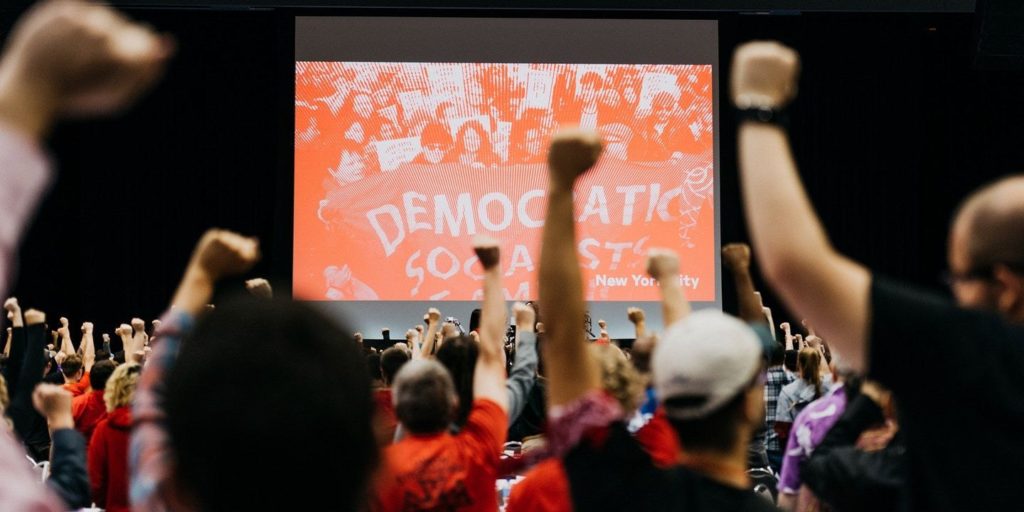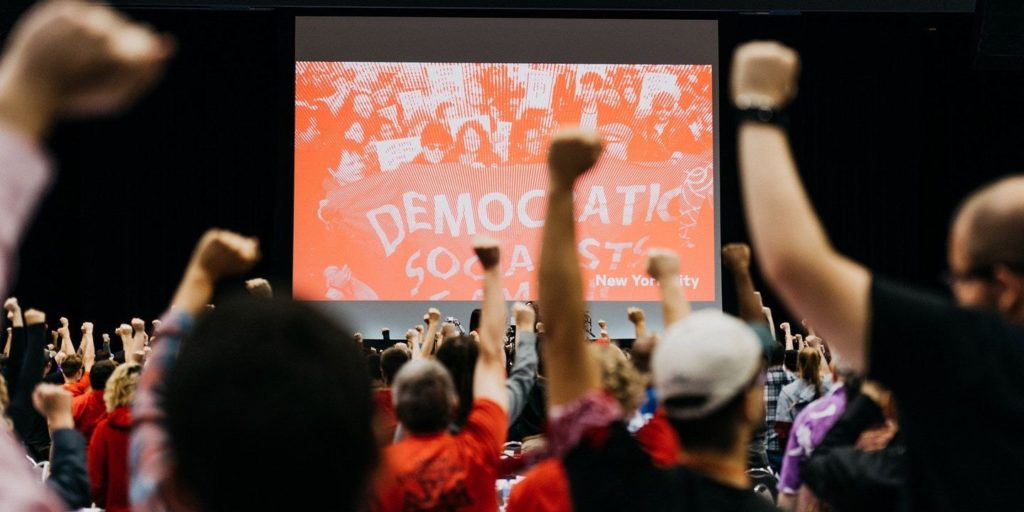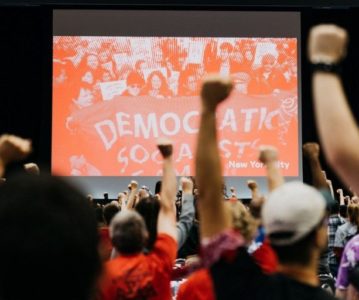Gabriel Pierre & Miah Simone report on the 2019 DSA convention. Response from members of the editorial board of Cosmonaut here.

The Democratic Socialists of America 2019 National Convention — aside from its size and historic importance in the context of a renewing socialist movement fraught with contradictions — was unique in a way not often covered in the copious amount of digital ink spilled over its proceedings since August 4. Amidst factional maneuvering and weaponized proceduralism, the actual political stakes themselves (and the strategic implications following) were often lost in the fog. On a surface level, it is exceedingly difficult to see what substantive differences among the caucus and non-caucus formations could possibly justify the level of veiled and open hostility. Much of the pre-convention discourse was indeed personalized and held in spaces obscured from the broader membership. But strategic decisions about how to build socialist power — and what constitutes power to begin with — have real-world consequences. Different class forces, particularly the ideas of the so-called middle-class petty bourgeoisie, find a reflection in socialist formations.
Since political lines of demarcation were so unclear, analysis of tendency has largely been grouped into two broad camps of ‘centralizers’ and ‘decentralizers’ — see for example Eric Blanc in The Nation1 or Tatiana Cozzarelli in Left Voice.2 Certainly it’s fair to say that Bread and Roses favors a stronger national center with campaigning priorities determined by that center and passed along to the chapter level, while something like the Libertarian Socialist Caucus would favor ground-level autonomy. But collapsing all of this into two camps both flattens tactics (the balance between ‘center’ and ‘local’ being subject to change based on task and circumstances) and buries the conflict over strategic outlook that is key to understanding what happened. Resolutions taking up the structure and internal organization of the DSA took up the most time on the convention floor. As we attempt to consolidate ourselves into something fit for purpose, the question is posed: do we need a member-driven radical organizing center rooted in the diverse working-class, or something along the lines of a hybrid between the top-down NGO model and social movement pressure group?
It’s interesting to observe the composition of these two groupings: the ‘centralizers’ are based in older chapters in major urban centers, backed by Jacobin, and joined by layers of comrades from the former International Socialist Organization. Their main focus was on getting as much support for the Bernie 2020 campaign as possible, shooting down anything which could remotely threaten the national’s intervention in the campaign (either explicitly or implicitly by drawing finite resources away from that project.) Their secondary focus was ramming through their Rank-and-File strategy3 resolution, despite the vast majority of newer members being in areas without unions or with anemic and bureaucratic locals. The question of whether the regeneration of the extant labor movement could coexist with conscious campaigning to organize the unorganized outside of historic trade unionist bastions or — as posited by the Rank-and-File strategy — whether these unions had to be radicalized as a precondition for the former loomed large through the weekend. In the end, R&F passed a floor vote alongside commitments to ‘organize the unorganized,’ including reforming the Democratic Socialist Labor Commission to facilitate that end.
The ‘decentralizers’ are largely from new chapters and Organizing Committees, many in rural and small city-based areas that formed after the Sanders or Ocasio-Cortez levies. Many work in areas that have had no socialist history for half a century or more (if it all). There’s also a not-insignificant minority among big city comrades, who have seen firsthand the practice of the ‘centralizers.’4 Frequently, often indirectly influenced by the Marxist Center movement, the main focus was in acquiring resources for these new comrades to build organization among these unorganized and inexperienced members of our class.
If we accept the division of the left into four tendencies divided by practice rather than stated ideology5, we see that floor debates mapped (admittedly roughly) to divisions between the ‘government socialist’ and ‘base builder’ approach. Resolution 57, granting coordinated support to the tenant organizing projects many chapters are already involved in, could have serious implications for organizing the class in the arena of social reproduction if followed through on. Resolutions to systematize and expand childwatch in DSA spaces and form a nationwide marshaling program are both worthwhile in their own right and important in creating operationally secure structures and opening the organization beyond layers of radicalized and childless white men. Surely we can all agree on the need for a socialist organization’s composition to more closely mirror the composition of the class as a whole, which includes many oppressed and marginalized peoples. But several measures with this need in mind were roundly defeated. A resolution granting institutional support to make our spaces accessible to comrades with disabilities, ‘Pass the Hat’ (which proposed a monthly stipend to chapters to stimulate our growth in rural and suburban/small city areas where far-right ideas march inexorably against a materially outmatched left), another redistributive dues measure, and the fairly self-explanatory ‘Nobody is too Poor for DSA’ (which made it easier for active comrades to acquire dues waivers) all failed to carry.
This seeming contradiction makes sense if the overriding objective is to elect left candidates to office and that objective is cast against building vehicles of independent working-class power. While the ‘realignment strategy’ appears now to be on its deathbed, measures like the ‘class struggle elections candidate pipeline’ replicate the problem of applying our finite resources to elect office-holders without meaningful accountability to the movement that elevated them.
Outside of explicitly structural issues, Resolution 9 to create a National Antifascist Working Group and the ‘anti-imperialist package’ resolution bundling Cuba solidarity, recommitment to the BDS campaign, and commitment to decolonization of the US Empire carried after an extended floor debate — both by a wire-thin margin. The closeness of the votes here reveal divergent perspectives: anti-imperialist practice is absolutely necessary if we see working people in the United States as one part of the world working class, but a potentially embarrassing liability if the outlook is to establish a social democratic reform regime premised on the super-exploitation of the neocolonial world and internally colonized people. That these passionately defended resolutions did pass is a testament to our ability to at least begin challenging the cult of US nationalism that permeates all social life in the world’s imperial hegemon.
It’s difficult to predict the future without a crystal ball. If the elections to the National Political Committee are any indication, the DSA is moving in a broadly leftward direction, with around half of the incoming NPC placed somewhere left of the DSA center. This trend will surely continue if the ‘decentralizers’ or base builders continue their growth on the frontier of the working classes. And more than adding up the sum total of votes for this or that measure, the process of creating political clarity in practice can’t be understated.
As the third largest socialist organization in U.S. history, coming forward after a period of general defeat for left-wing and working class struggles around the world, it seems only natural that the Democratic Socialists of America is an arena where contradictory perspectives are worked out — we are learning how to fight again. With the climate crisis accelerating social breakdown and the rise of the extreme right, we need to learn quickly. Although serious differences in outlook so often remain obscured, DSA remains a source of hope for the liberation struggle against all forms of oppression and domination to be reforged.
- https://www.thenation.com/article/dsa-convention-sanders-atlanta-socialism/
- https://www.leftvoice.org/dsa-convention-2019-this-is-not-what-democracy-looks-like
- https://www.jacobinmag.com/2019/06/rank-and-file-strategy-kim-moody-labor-unions
- https://medium.com/@leftunitypdsa/open-letter-from-dsa-members-new-to-the-philadelphia-local-927e564b6398
- https://medium.com/@sophia.burns/the-us-left-has-only-four-tendencies-816746c27b51




